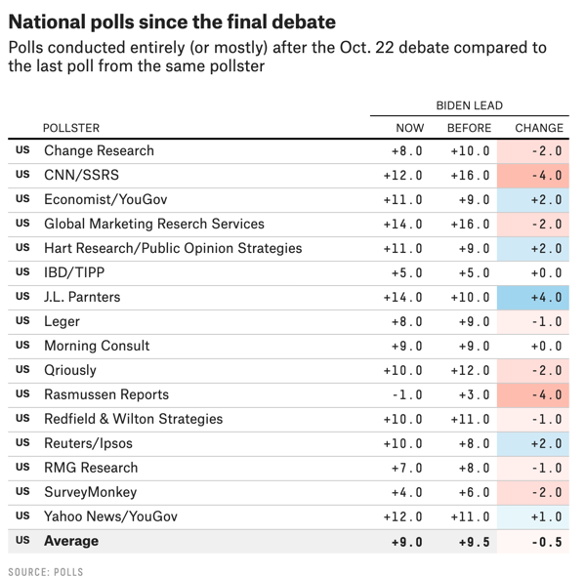
As is often said, politics is a game of expectations. Beat the expectations and you gain momentum. If you fall short, the campaign and candidacy of a person is in trouble. With that as the context, and survey research as our guide, who won the second presidential debate?
Let’s start with expectations. Despite the addition of the mute button, many were wondering if Trump was going to show up for this debate ready to take the gloves off once again. On the other hand, pundits were speculating if the uninterrupted portions would allow Biden to devolve into a blundering gaffe machines. Ultimately, neither did. According to poll by Axios and Survey Monkey, 44% thought Trump did better than expected. Sixty-one percent thought Biden met their expectations and preferred him to Trump on a number of issues. Joe Biden did good enough and Donald Trump didn’t hurt himself.
What did the two candidates want to accomplish with the debate? For the Trump campaign, they needed a radical change in the trajectory of the race. For Biden it was to not rock the boat – stay on message and get out of the evening whole. Now, remember after the first debate, Biden increased his FiveThirtyEight aggregate lead from 7.6% to 9.1%., a nearly 20% increase. As we will see, nothing like that happened for either side, so it seems like Biden achieved his objective and Trump did not.
Finally, before we look at a week’s worth of numbers, let’s take a quick look at the flash polls after the second debate. CNN had 53% saying Biden won. A FiveThirtyEight / Ipsos poll said 51.8% rated Trump’s performance as good versus Biden’s 68.7% positive performance rating. This same poll gave Biden higher marks than Trump on policy. Based on these immediate numbers, Biden could claim a win.
But that is not how we are measuring this.
As was said in my analysis of the first debate, both RealClearPolitics and FiveThirtyEight release a ton of polling data every Wednesday. For each debate, this data dump included polls that were completely taken after the contests.

To start we are going to look at approval ratings. In the FiveThirtyEight aggregate, Trump gained a bit from October 22nd to October 28th in the approval department. There was a slim decrease in the disapproval, but the gap was still over ten points. In the above mentioned poll, Biden is viewed favorably by 46% of respondents vs. 45% disapprove. Other polls have also shown Biden with a higher favorable to unfavorable rating. It is a key difference from 2016, where both Trump and Hilary Clinton had net unfavorable ratings.

Now let’s look at the national and battleground polls. Remember, there was a swing in Biden’s direction last time. We are going to add a new wrinkle and see if there was any difference in the battleground polling.
As seen here in the FiveThirtyEight chart, the Biden lead went from an average of 9.5% to 9%. Going to the RealClearPolitics numbers there was very little change to the national numbers, but the battlegrounds did tighten. While, Biden has a projected lead, it has narrowed.

Finally, looking at the aggregate national number and battleground number from FiveThirtyEight we see that the race did narrow a bit. Biden lost a full percent off of his margin and the race tightened in Pennsylvania and Arizona.

Last time around, we introduced something I like to call the “close the deal” number. That is the difference between those who are voting for Biden versus. those that disapprove of Trump. For Trump that means the amount of people that approve of his presidency compared to the amount of people who are voting for him. At this point it is important to note that we are not doing anything to measure whether either side has expanded the demographics voting for them or the amount of people who are being persuaded to their side.
Trump’s vote is almost equal to his approval rating. In other words, he has a rock-solid base. As for Biden, there is still some work to be done between now and the final second of voting. The FiveThirtyEight aggregate shows that there is a full 2% difference (51.8% voting for Biden vs. 53.8% disapproving of Trump). This 2% difference doesn’t seem like a lot, but when swing states come down to thin margins this amount can make all the difference. As it stands, if this two percent goes either toward Biden, split between the two, or votes third party, then you are looking at a new president. If the majority of this percentage moves to Trump, there could be a long election night.
Ok, enough. Who won the debate? Trump did not radically change the trajectory. Biden did not salt away the race and leave Trump in the dust. So, we are going to the world of boxing to render a split decision. Biden won… by the narrowest of margins.
______________________________________________________________________________________________________________________

Jim Bloom
Jim Bloom is a marketing executive currently located in Dallas, TX. He has been involved with several digital, mobile, and social startups. Bloom also directed the marketing of the Moneyball era Oakland A’s and Toronto Blue Jays.
______________________________________________________________________________________________________________________






